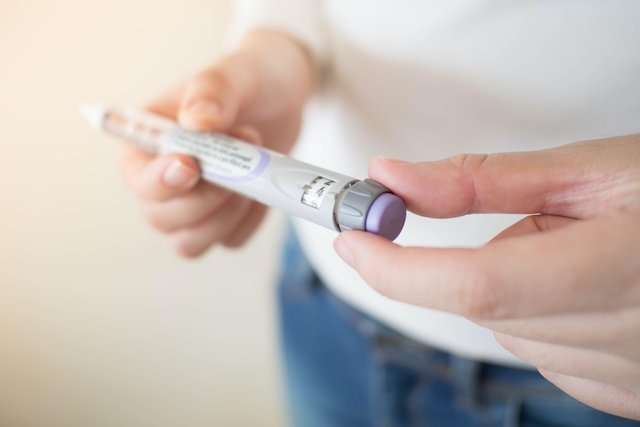Saxenda is an injectable medicine used for weight loss in obese or overweight people, as it helps reduce appetite and control body weight, and can cause a reduction of up to 10% of total weight, when associated with a healthy and practical diet. of regular physical exercise.
This medicine contains liraglutide in its composition, which acts on the regions of the brain that regulate appetite, making you feel less hungry and, therefore, weight loss occurs by reducing the number of calories consumed throughout the day.
Saxenda is found in pharmacies or drugstores, in the form of a pen for application under the skin, containing 3 mL of liraglutide injectable solution, sold with a prescription. This medicine should be used in the doses and for the duration of treatment recommended by the doctor.
Watch the following video and learn about other remedies that help you lose weight:
What is it for
Saxenda is indicated for the treatment of:
- Obesity com IMC superior a 30 kg/m2;
- Overweight com IMC superior a 27 kg/m2associated with diseases such as high blood pressure, diabetes mellitus, dyslipidemia or high cholesterol.
The body mass index (BMI) classification helps to calculate and indicate what the ideal weight should be, and can help with diet and weight loss planning. Find out what your BMI is using our online BMI calculator.
How to use Saxenda
Saxenda should be used as directed by a doctor, and the recommended dose is 1 application per day subcutaneously, that is, under the skin of the abdomen, thigh or arm, at any time, regardless of meal times.
Saxenda doses depend on the week of treatment and include:
The maximum dose of 3 mg per day should not be exceeded. It is important to remember that you must follow the treatment plan indicated by your doctor, and the doses and duration of treatment must be respected and carried out according to medical advice.
If you forget to apply a dose at the correct time, you should apply it as soon as you remember. However, if more than 12 hours have passed, you should skip the missed dose and apply the next dose at the normal time. Do not double doses to make up for a forgotten dose.
During treatment with Saxenda, you must follow a dietary plan with a balanced diet, preferably associated with regular physical exercise recommended by your doctor. Check out healthy weight loss tips and how to create a dietary program.
How to give the injection
To correctly apply Saxenda to the skin, the following steps must be followed:
- Remove the pen cap;
- Place a new needle on the tip of the pen, screwing it until tight;
- Remove the outer and inner protection from the needle, throwing away the inner protection;
- Rotate the top of the pen to select the dose indicated by the doctor;
- Insert the needle into the skin, making a 90º angle;
- Press the pen button until the dose marker shows the number 0;
- Count slowly to 6 with the button pressed and, only then, remove the needle from the skin;
- Place the outer needle cap and remove the needle, throwing it in the trash;
- Attach the pen cap.
If you have any doubts about how to use the pen, it is important to consult a healthcare professional to receive the most correct instructions.
How long does 1 Saxenda pen last?
The duration of the Saxenda pen depends on the week of treatment being carried out, and the pen has a scale that shows how many mg remain to be applied.
In general, each box of Saxenda contains 3 pens that are sufficient for 3 months of treatment, when using the minimum recommended dose and stored correctly.
Saxenda should be stored in the refrigerator, at temperatures between 2º and 8ºC, and it is advisable not to store it in the door, to avoid temperature variations. Furthermore, after starting to use the pen, Saxenda is valid for 1 month, when stored in a refrigerator or at room temperature, below 30ºC. After this period, any unused quantity must be discarded.
Possible side effects
The most common side effects that may occur during treatment with Saxenda include nausea, vomiting, diarrhea, constipation, headache, dizziness, tiredness or loss of appetite.
Although it is rarer, indigestion, gastritis, gastric discomfort, pain in the upper region of the stomach, stomach paralysis (gastroparesis), heartburn, feeling of fullness, increased belching and intestinal gas, dry mouth, weakness or tiredness, changes taste, gallstones, injection site reactions.
Furthermore, Saxenda can cause hypoglycemia, which is a decrease in the amount of sugar in the blood, which can be noticed through symptoms such as increased hunger, excessive sweat production, irritability, dizziness, racing heart, feelings of anxiety or tremors. It is important to inform the doctor when the person presents these symptoms.
Saxenda can also cause serious allergic reactions that require immediate medical attention. Therefore, you should stop treatment and seek the nearest emergency room if you experience symptoms such as difficulty breathing or swallowing, heart palpitations, dizziness, a feeling of a closed throat, swelling in the mouth, tongue or face, or intense itching. Know how to identify the symptoms of a serious allergic reaction.
Saxenda can also cause a rebound effect, especially after stopping treatment without guidance and monitoring from an endocrinologist.
Read too: Rebound effect: what it is, symptoms, causes (and what to do)
Who shouldn’t use
Saxenda should not be used by children and adolescents under 18 years of age, pregnant or breastfeeding women, or by people who are allergic to liraglutide or any other component present in the medicine.
Furthermore, Saxenda should not be used by people who have or have had a thyroid tumor, or who use other GLP-1 receptor agonist medications, such as Victoza, for example.

Sign up for our newsletter and stay up to date with exclusive news
that can transform your routine!




